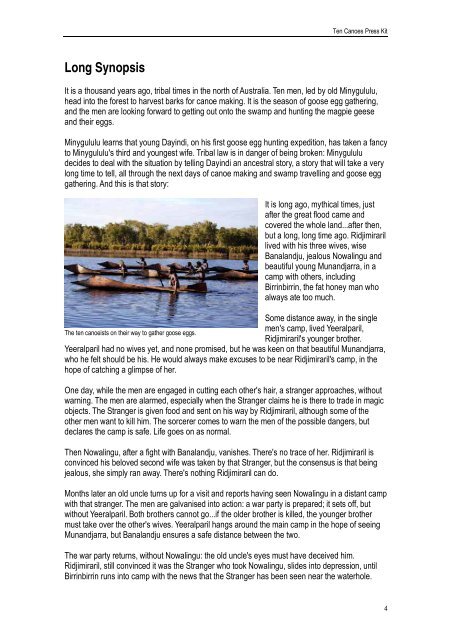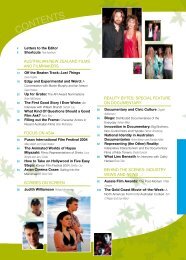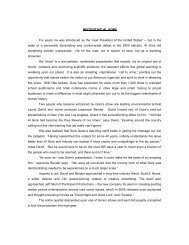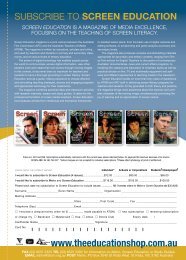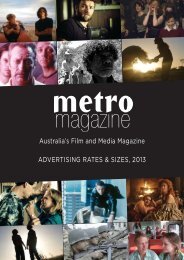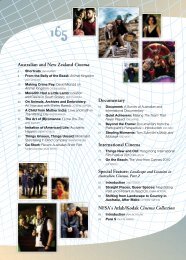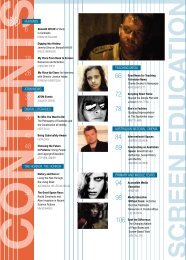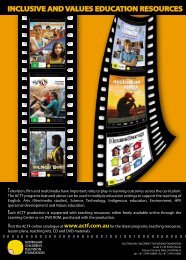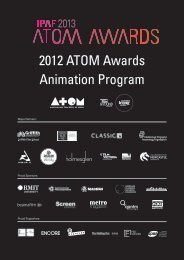Background - Metro Magazine
Background - Metro Magazine
Background - Metro Magazine
- No tags were found...
You also want an ePaper? Increase the reach of your titles
YUMPU automatically turns print PDFs into web optimized ePapers that Google loves.
Ten Canoes Press KitLong SynopsisIt is a thousand years ago, tribal times in the north of Australia. Ten men, led by old Minygululu,head into the forest to harvest barks for canoe making. It is the season of goose egg gathering,and the men are looking forward to getting out onto the swamp and hunting the magpie geeseand their eggs.Minygululu learns that young Dayindi, on his first goose egg hunting expedition, has taken a fancyto Minygululu's third and youngest wife. Tribal law is in danger of being broken: Minygululudecides to deal with the situation by telling Dayindi an ancestral story, a story that will take a verylong time to tell, all through the next days of canoe making and swamp travelling and goose egggathering. And this is that story:It is long ago, mythical times, justafter the great flood came andcovered the whole land...after then,but a long, long time ago. Ridjimirarillived with his three wives, wiseBanalandju, jealous Nowalingu andbeautiful young Munandjarra, in acamp with others, includingBirrinbirrin, the fat honey man whoalways ate too much.Some distance away, in the singlemen's camp, lived Yeeralparil,The ten canoeists on their way to gather goose eggs.Ridjimiraril's younger brother.Yeeralparil had no wives yet, and none promised, but he was keen on that beautiful Munandjarra,who he felt should be his. He would always make excuses to be near Ridjimiraril's camp, in thehope of catching a glimpse of her.One day, while the men are engaged in cutting each other's hair, a stranger approaches, withoutwarning. The men are alarmed, especially when the Stranger claims he is there to trade in magicobjects. The Stranger is given food and sent on his way by Ridjimiraril, although some of theother men want to kill him. The sorcerer comes to warn the men of the possible dangers, butdeclares the camp is safe. Life goes on as normal.Then Nowalingu, after a fight with Banalandju, vanishes. There's no trace of her. Ridjimiraril isconvinced his beloved second wife was taken by that Stranger, but the consensus is that beingjealous, she simply ran away. There's nothing Ridjimiraril can do.Months later an old uncle turns up for a visit and reports having seen Nowalingu in a distant campwith that stranger. The men are galvanised into action: a war party is prepared; it sets off, butwithout Yeeralparil. Both brothers cannot go...if the older brother is killed, the younger brothermust take over the other's wives. Yeeralparil hangs around the main camp in the hope of seeingMunandjarra, but Banalandju ensures a safe distance between the two.The war party returns, without Nowalingu: the old uncle's eyes must have deceived him.Ridjimiraril, still convinced it was the Stranger who took Nowalingu, slides into depression, untilBirrinbirrin runs into camp with the news that the Stranger has been seen near the waterhole.4
Ten Canoes Press KitRidjimiraril tells Birrinbirrin he's going to talk to the stranger but grabs his spears and takes off,Birrinbirrin puffing behind.Deep in the bush they see the Stranger, squatting for a shit. Ridjimiraril launches a spear. Aninspection of the body, however, reveals that Ridjimiraril has killed the wrong stranger. There aresounds of approaching people. Ridjimiraril breaks the spear off and they quickly hide the body.But they did not hide that body well enough. Days later Ridjimiraril and Birrinbirrin are accostedby a group of warriors including the Stranger. They have identified the spearhead in theStranger's brother's body as having been made by Birrinbirrin, and they want payback. Ridjimirarilowns up, and the location and time for the payback ceremony is agreed to.A sad little procession of men leave camp for the payback. This time Yeeralparil can go, as onlyone person is to be speared, either Ridjimiraril or his payback partner. Yeeralparil argues that itshould be he, young and nimble, who ought partner his brother. Ridjimiraril agrees, and togetherthe two brothers face the spears from the aggrieved Stranger's tribe. That is the law, and the lawmust be upheld.Ridjimiraril is speared. Justice done, he is helped backto camp. Banalandju tends his wound, but instead ofgetting better, as he should, Ridjimiraril declines: it is asif a bad spirit has invaded his body. Even the sorcerercan do nothing. In his last moments before dying,Ridjimiraril staggers to his feet and begins to dance hisown death dance...then he collapses and dies.After all the correct ceremony has been performed,Yeeralparil finally moves into the main camp, to be withhis Munandjarra. But he's inherited a great deal morethan he expected...Minygululu's story is over, the goose egg hunters returnhome. Dayindi has learnt his lesson, and whenopportunity presents, he declines...maybe some day hewill have a wife, but it won't be someone else's.Ridjimiraril's death dance.5
Ten Canoes Press KitGlossary and ExplanationsBelow are a number of terms used by the people local to the area where the film was made,which may need explanation. There are also some places and processes that are helpful to knowabout when reading the press kit or writing about the film.Yolngu: The literal translation of Yolngu is simply, "the people", but it is used nowadays as a termto describe the group of Australian Indigenous people (aboriginals) living in or originating fromcentral and eastern Arnhem Land in Australia's Northern Territory.Balanda: A word meaning "white person(s)", coming from the word "Hollander"...the Dutch werethe first white people to come into contact with the Yolngu.Ramingining: A town of about 800 Yolngu people in the northern part of central Arnhem Land. Thetown was created in the early 1970s when the Mission of Millingimby became overcrowded. Thismeant that Yolngu from different areas were brought to live together, some quite a long distancefrom their traditional lands. There are fifteen or sixteen clans represented in Ramingining andabout 8 different language groups.Arafura Swamp: A large area of freshwater wetlands just south and east of Ramingining. Theswamp extends to 130,000 hectares during the wet season, and is home to an incredible varietyof bird, plant and animal life, including possibly the largest biomass of crocodiles in the world.Magpie geese or Gumang: One of the many species of birdlife on the swamp, the Gumang is ablack and white native goose which was an important food source in times gone by.Goose Egg Gathering: Also known as Goose Egg Hunting. Expeditions by canoe of up to a weekat a time used to be launched onto the swamp towards the end of the wet season, when themagpie geese had laid their eggs. Eggs were collected in numbers and the birds hunted for theirmeat.Ganalbingu: The name of one of the clans local to the Arafura Swamp area. Ganalbingu means"magpie goose people". It was hence an important clan in the life of the swamp (and in themaking of 'Ten Canoes').Payback, or Makaratta: A formal and ritualised form of punishment or retribution, usually withattendant ceremony. Warriors from the aggrieved tribe throw spears at the perceived culprit untilblood is drawn. Sometimes the wound is fatal, sometimes only minor. Occasionally a partner ischosen by the culprit, and both face the spears. Justice is deemed to be done when either one,the innocent or the perceived guilty, is hit. In many areas payback has been further refined to be asimple close-range spearing of the culprit in the leg.Death Dance: When someone was at the edge of death, ceremony would start. People wouldgather and initially a dance would be performed for the dying person, to help him begin to makeconnections with his ancestors in the spirit world. Occasionally a person, still capable but knowinghe was going to die, would perform the death dance himself. Ceremony would continue on andoff for up to twelve months after the person had died.6
Ten Canoes Press KitThe Place7
Ten Canoes Press KitWe Need Ten Canoes!...Origin of a FilmThe country of the Arafura Swamp area is traditional to David Gulpilil, the great Indigenousperformer (dance, film, theatre) who is an Australian screen icon. When not out performingsomewhere in the world, David generally lives in Ramingining, close to his traditional land,although more recently Darwin has also been a home.Towards the end of 2000, David was cast as the lead in the film that was to become 'The Tracker'.Upon meeting director Rolf de Heer in Adelaide some months before the shoot, David invited Rolfto Ramingining, to meet with him among his family, to see his traditional lands, to travel theArafura Swamp. Rolf accepted the invitation and the two of them spent the time betweenChristmas and New Year together, talking, fishing, eating bush food and learning to understandeach other. Even then David was keen on Rolf making a film up there with him and his people.During the filming of "The Tracker", and on a number of subsequent occasions, David renewedhis invitation to Rolf to make a film in Ramingining, any film, maybe a Western with cowboys andcattle, or a massacre film, even "The Tracker 2". Finally, in June 2003, David received a phonecall from Rolf...could he come up and talk to David about making a film together, David to star in itand be the co-director, all shot up there on the traditional lands of his people, in their language.The initial discussions that took place included a number of David's influential contemporaries,such as Richard Birrinbirrin and Bobby Bunungurr. A vague decision about the nature of the filmwas made: set it in "old times", maybe a century ago; make it some sort of Aboriginal story thatends, just before its own climax, with the massacre by Balanda of most of the Yolngu characters.This was not, however, to last very long as the idea for the film.On the morning of Rolf's departure, David came tosee him. "We need ten canoes," said David. Rolflooked at him blankly. "We need ten canoes,"David repeated. Suddenly Rolf understood thatDavid meant this for the film. "David, we don'teven know what the film is really about, how canwe need ten canoes?". David looked at Rolf as theignorant Balanda he was and left, re-appearinghalf an hour later with a photo, black and white,taken almost seventy years before. Rolf took onelook at it and said, "You're right, we need tencanoes".The ten canoeists in the style of Donald Thomson'sphotograph.The photo, of a group of ten men in their barkcanoes on the swamp, was profoundly cinematic.It spoke of a world of long ago, where things weredifferent, life was different to anything that couldbe imagined by almost any Balanda anywhere. Toenter that world would be the essence of realcinema. And there were more of these photos.The film had started to form.8
Ten Canoes Press KitThe Donald Thomson PhotographsThat photo of the ten canoeists was taken by Dr Donald Thomson, an anthropologist who workedin central and north-eastern Arnhem Land in the mid-1930s, when life for the original inhabitantswas still very traditional and culturally little influenced by the coming of white people...there hadbeen wars against the Yolngu people of Arnhem Land, and massacres of them, but they hadnever been conquered and had thus retained, in very large measure, their traditional lifestyle.Thomson lived there with the people for many months, by himself, funded by the government inthe hope that understanding the Yolngu would bring peace, not only with the outside world, butamongst the warring factions of Yolngu themselves. Though many of his specificrecommendations were ignored, he was very largely successful with his broader aims.Thomson left a legacy of immense importance. He was an extraordinary photographer, of bothstill and moving image. The Thomson Collection of some four thousand black and white glassplate photographs of so many aspects of Yolngu culture is held in Museum Victoria (there areanother seven thousand photographs taken in Central Australia and on Cape York); the manythousands of feet of nitrate film he took were all lost in a Melbourne warehouse fire.The photographs are of many things...they depict dailylife, like gathering and preparing food; they documentthe creation of artefacts like canoes and huts andspears; they trace special events, like a goose egghunting expedition; they show people, a great range ofpeople, precisely what they looked like and how they didtheir hair and what they wore...they are a portrait of apeople in a slice of time that would otherwise have beenlost.Some of these photos have made their way back toRamingining, and there they're considered with a lotmore than idle curiosity. They've been consumed by theculture, become part of it. There's such a concept as"Thomson Time", fondly remembered. The web ofkinship is complex: everyone is related to someone inthe photographs, and everyone takes pride in them.They are their continuity, their history.Peter Minygululu and Jamie Gulpilil collectingmagpie geese eggs, in the style ofDonald Thomson's photograph.9
Ten Canoes Press KitLife Then, Life NowLife for the pre-contact Yolngu may have had its hard times, but the Yolngu had adapted verysuccessfully to their environment. Their ceremonial and spiritual life was extremely rich andcomplex, due in part to the abundance of the food supply...Yolngu spent a lower proportion oftheir time obtaining food than any other known Australian Indigenous tribe; this allowed themmore time to develop ritual and ceremony.They were semi-nomadic hunters and gatherers, moving seasonally within well-definedboundaries depending on the best availability of food. They had a very complex kinship system,which determined extremely strict marriage rules; a highly developed system of law; and anextensive trading network with other tribes great distances away.Macassans from the island of Sulawesi in Indonesia began to visit five or six hundred years ago,introducing new technology and a new economy. In return for camping rights and Yolngu helpwith their trepang (sea slug) fishing, the Macassans would trade items such as metal knives andaxes, unknown in Australia to that point. That gave the Yolngu real advantage when ontrading toother tribes.Western culture, mainly in theform of cattlemen, didn't reallyarrive until the 1880s, andwas strenuously resisted.Many Yolngu weremassacred, but the Yolngucontinued to hold out againstwhite incursion. It was notuntil Thomson in the 1930sthat peace, and ultimately aconversion to a mixture ofwhite and Yolngu ways, came.Nowadays life is very differentfor the people of Ramingining.There is a supermarket and aRichard Birrinbirrin at Ramingining airstrip.takeaway shop. People live inhouses with plumbing andtelevision, and do their banking over the internet. Some of the old ways remain: the kinshipsystem, though modified, is still strong; some of the ceremonial life is as important as it was acentury ago; people still go hunting and fishing, though 4-wheel drives, guns and fishing lines areincreasingly the tools of choice. Conventional work is scarce and increasingly there isengagement with the arts and craft, which in turn helps keep some of the traditions alive.10
Ten Canoes Press KitA Story to Please Two CulturesIt was with this community in transition that the story and script for the film were created. TheYolngu storytelling tradition is strong but its conventions are very different to those of Westernstorytelling. It was soon clear that the challenge would be to create a story, to make a film, thatwould not only satisfy local tastes and requirements, but that would also satisfy a Westerncinema-going audience, used to Western storytelling conventions.The Thomson photos were a great starting point. They were an invaluable reference, and havingbecome part of the local culture, here were images that could be discussed, incident that could bederived from image...each photo had, in some way, a story that illuminated the whole of theendeavour.Over the next year and a half, Rolf visited Ramingining on numerous occasions. Each time hecame, more of the Yolngu would get to know him, and the circle of consultation became wider.This was crucial because by now David Gulpilil, Rolf's initial chief collaborator, was spendingmore and more time away from the community, but the work of the film had to continue.There were several storytelling problems that needed to be overcome. The first of these was thedesire of the locals who worked with Rolf to have the process of goose egg gathering (the tencanoes photo was taken during such an expedition) central to the film. The practice, and theceremony that went with it, had been discontinued many years before, and it had been decadessince one of the specialised swamp canoes had even been made. There were thoughts of arevival, and the film seemed an opportunity to trigger that revival. The only problem was thatgoose egg gathering itself is particularly non-dramatic in the paradigm of Western cinema.'Drama' was also a problem of what should not be in the film. The old times, Thomson Time andbefore, were precious to the community, part of cultural continuity, and the Yolngu collaboratorsdid not want to depict them as times of conflict. And conflict, being the essence of drama, wasessential if the film was to work also for a Western audience.And the third major problem was thatthe Thomson photos, which weresomehow being represented in thefilm, were in black and white...thecultural history of the people was inblack and white, but the film wascontractually bound to be a colour film.In the end, those and other problemswere solved by introducing one deviceinto the film, which was to have themain dramatic part of the story set inmythical times, when for the YolnguMichael Dawu and Frances Djulibing in the Stranger Abducts scene.anything was allowed to happen, andshoot that part in colour...that dramatic story could then be told as a cautionary tale during agoose egg hunting expedition, which would be shot in black and white to reflect the Thomsonphotos. A script which pleased both cultures was then possible.11
Ten Canoes Press KitLanguage...the Cosmological DivideAs noted before, Ramingining is a place of many languages. People speak to whoever in theirown clan language, which is well understood by most others, who then tend to reply in their ownparticular language, also understood by most.In the film, for example, a number of the ten canoeists are Ganalbingu speakers, but Minygululuspeaks Mandalpingu, also David Gulpilil's language. Crusoe Kurddal, who plays Minygululu'sancestor Ridjimiraril, speaks another language still, one from Maningrida about 150kms west ofRamingining. But in general, each understands the other perfectly well and apart from some onsetmerriment about the way something would be said in a language other than Ganalbingu, eachwas perfectly comfortable acting with someone who spoke a different language.“Canoeists” on the first day of the shoot - Michael Dawu, Steven Wilinydjanu, CrusoeKurddal, Jamie Gulpilil, Carl Dhalurruma, Billy Black, Bobby Bunungurr, PeterMinygululu, Peter Djigirr, and “Sorcerer” Philip Gudthaykudthay (Pussycat) seated.For many of the Yolnguresidents though, English isperhaps their fifth or sixthlanguage...they speak it onlyrudimentarily if at all. Theyunderstand a little more thanthey can speak, but notspeaking it, it becomes verydifficult to know what of it theyunderstand. And there is animmense difference betweenthe Yolngu languages on theone hand (how they arespoken and structured, theirtenses and syntax, even thevery cosmology theydescribe), and English on theother hand.In David's absence then (he pulled out of the film for complex reasons some weeks before theshoot), it was fortunate that several of the cast, notably Peter Djigirr and Richard Birrinbirrin , plusFrances Djulibing among the women, were good English speakers. They and others would workthrough the two-way communication problems between actors and director until everyoneseemed well to know what to do and what to say.A good example of the difficulties encountered was when there was an attempt to write downsome material for Minygululu, who spoke little English, so that he had a better opportunity to learnwhat roughly he should be saying. In the event it took five people to achieve the task...Rolf wouldexplain the sense of the words to Djigirr and Billy Black, who would discuss and restructure inGanalbingu and present this to Minygululu. Minygululu would then restructure further and tellFrances Djulibing in Mandalpingu how he would say what was required, and Frances would writeit down according to Yolngu phonetics. But despite understanding Mandalpingu perfectly andbeing a fluent reader, Frances literally could not make sense of the words when trying to readthem back. The three Yolngu men could not read, so it was left to the Balanda director to read itback in Mandalpingu for checking, though not without an immense amount of mirth at the fluentbut badly pronounced language coming out of his mouth. The attempt was so time-consumingthat it was soon abandoned.12
Ten Canoes Press KitWho Does the Casting?Another area of unusual problem was the casting of 'Ten Canoes'. There were a number ofstages to the casting, and each was more unconventional than the previous.The first stage was during the construction of the story. Those participating in the story consultinghad clear claims to being in the film and assumed they would be in it, but they weren't alwaysobvious casting. Birrinbirrin, for example, was substantially overweight, in a way that no Yolnguwas even seventy years ago, let alone pre-contact. And so a role was created especially for him,a comedic part of a man always after honey and always eating too much. This made hisappearance in the film not only credible, but a real contribution to it.Then there were the canoeists. Theten men in Thomson's canoes photohave, over the years, beenindividually identified, and many inRamingining are related in someway to at least one of them. Thosewith the strongest claims to heritagechose themselves to play theirancestor, as they saw it, and thatwas the end of that. So much fordirectors being all powerful.Honey Man Richard Birrinbirrin with Rico Pascoe and Scott Gaykamangu. The third stage of casting was themost complex. If the characters inthe film had a certain kinship relationship (for example a man and his wife), then the actorsplaying those characters also had to be able to have that kinship relationship. Every Yolngu isclassified as being of one of two moieties: everyone is either Yirritja or Dhua. A Yirritja man cannotbe married to a Yirritja woman, and hence half the women in Ramingining, being Yirritja, wereimmediately excluded from consideration for that role. But then there are a number of moietysubsections...if you're of the wrong Dhua subsection, then you can't be seen on screen as beingmarried to a Yirritja man either...half of the rest of the women excluded. And if a character has arelationship with two other characters, then both relationships have to conform to the kinshipsystem. From an already small pool of available actors, there was sometimes only one personwho was possible for a particular role. No such thing as screen testing...if someone culturallyappropriate and willing was found, they had the part, irrespective of looks or ability. And in thefinal reckoning, they all had both the looks and the ability.13
Ten Canoes Press KitThe First Swamp CanoeAs the shoot drew nearer, it became time for the Yolngu to begin making all the artefacts neededfor the production: the spears and stone axes; the dilly bags and canoes; the arm bands and theshelters. As in old times, the work was divided very distinctly along gender lines...the men madethe canoes and the weapons, the women the huts, the bags and the body decorations. At eachstep there was the feeling of doing something special, of cultural renewal, of bringing back the oldtimes.The canoes were a particular example of this. The canoes of the Arafura Swamp were of a designand function that took into account the precise environmental conditions of the swamp. Therewere no other canoes like them anywhere in Australia, but none had been built here for decades.The expertise, however, still existed among the older men, in particular with Minygululu (in hissixties) and Pussycat (mid-seventies). Minygululu was away, so Pussycat, ably assisted by Djigirrand Dawu and several others, went bush to find barks.Appropriate trees were selected and a sheetof bark up to four metres long and a metrewide was cut and pried off each tree in asingle piece. The barks were soaked in acreek overnight and then the next morningfirewood was gathered, and sticks from acertain plant to provide the string to sew thecanoes, and sticks from a certain shrub toprovide the supports. The first bark slab wasremoved from the water and thrown on thefire, heated through and softened, then bentinto shape and clamped between two sticksthat had been driven into the mud. One endwas sewn, then back onto the fire for the other end, the prow.Peter Djigirr cutting bark for the first canoe.There was gathering excitement, more so among theyounger men who had never seen this before, as thecanoe took shape. Then a moment'shesitation...Pussycat is not originally from one of theswamp tribes and was unsure about the exact way tosew the prow. Thomson photographs were consulted,and a drawing by Thomson in his monograph about thegoose egg hunters. Work resumed in a new direction,and when the prow took shape in the manner of a"Thomson canoe", there was a sudden understandingand real pride.Pussycat secures the canoe supports.14
Ten Canoes Press KitBy the end of the day, the first canoe had been completed. It sat there on the ground, on display.One of the younger men kept stepping into it and miming the poling action. The older men walkedround it, admiring it. This one canoe was a small miracle, even for the Yolngu...forgotten aspectsof their culture were being brought back from the brink extinction, and they knew it.Steven Wilinydjanu tests the first canoe.15
Ten Canoes Press KitThe CampMeanwhile the production crew arrived and began to transform Murwangi, an old cattle station atthe edge of the swamp which was to serve as the base for filming, into something at leastnotionally habitable. Tent city sprang up among the scattering of rusty sheds, but at least therewas power, a kitchen and some bathroom facilities (including an open air shower and toilet thathad a grand view of the swamp but that was hell with mosquitoes).The Yolngu cast were delighted with their accommodation...the tents had power, a light and a fan,and were largely mosquito proof. The citified crew had slightly different ideas about it all, andresigned themselves to many weeks of roughing it. Everything is relative...The camp was a living, vibrant,noisy entity. The cast generallybrought wives, husbands andfamilies and friends, and it wasnot long before more tents hadto be shipped in toaccommodate the overflow.Children played around thecamp and roamed thesurrounding areas, those notworking would go fishing orhunting and often enough thecrew and cast would return froma day's shooting to the smell offresh fish cooking on little firesscattered throughout the camp.Murwangi Station and the beginning of tent city.Extra food had to be shipped in to alleviate the pressure on catering...more than once there wasan unexpected influx of visitors and all the food was gone before everyone had eaten. TheBalanda crew, to their credit, took the stresses mostly in good humour. It was not easy for them,working hard through the hot days, then returning to a noisy, mosquito plagued camp with foodshortages, no alcohol to wind down, nowhere to go to get away from it all, not even any realrespite in one's own tent because it was surrounded by other tents, other people.But there was a real benefit to this cheek-by-jowl living, and that was on set. The Yolngu and theBalanda, by their enforced closeness and intermingling during time away from shooting, werevery quickly and very substantially demystified to each other, both personally and culturally.Accommodation to each other's ways was found in camp, had to be found. This led to a very easyand trusting atmosphere on set, which was generally much calmer and quieter than camp. Withthe increased understanding of both cultures, people were able to really enjoy working togetheron set.16
Ten Canoes Press KitCrocodiles, Leeches and MosquitoesThe shoot itself was divided into distinct halves. First would be the black and white canoe makingand goose egg gathering material, based on and at the edges of the swamp, then would comethe colour material from the mythical times, to be shot mostly at the camp the Yolngu women hadbuilt and also in the forests and surrounds.Of the goose egg hunting expeditions, Thomson wrote, in 1937, "...the irritation and loss of sleepdue to the bites of mosquitoes and leeches, added to the physical exertion, makes the journey asevere ordeal." That describes fairly accurately the first half of the shoot. And crocodile numbersin the Arafura Swamp had built up enormously since hunting them became regulated in the 1970sand to the crew and cast, so had mosquito and leech numbers.The swamp shoot was a long, hard haul for Yolngu actor and Balanda crew alike, much as agoose egg hunting expedition would have been. None of the cast had acted in a film before, andthey were not only having to relearn old skills, such as poling a bark canoe through thick reedswithout falling out, but they had to learn the new skills associated with screen acting, understandthings like shooting out of sequence, storytelling that was fictional rather than based on reality, aseven the most distant myth has a reality level to it for Yolngu that Balanda find difficult tounderstand.And there was also a sense of responsibility forthese mad Balanda, who obviously weren't aware ofthe dangers of the swamp, otherwise why wouldthey stand, vulnerable to crocodiles, waist-deep inthe swamp all day? Good to have a croc spotterwith a gun, even though old Pussycat's eyesightwas deemed questionable, but better still to havecroc spotting as a way of life, which it is for thelocals. And so it was that there were eleven crocspotters on set, the ten canoeists plus Pussycat,enough to ensure the safety of the Balanda.First screening of rushes was both riotous andawesome. Every Yolngu in camp crammed into theediting hut and every Yolngu in camp laughed at therepeated antics of the cast, and at what they said.But the style of the black and white filming had beenchosen to reflect the Thomson photographs, and ina number of cases the shots, down to composition,had been planned to almost duplicatethem...whenever such a shot appeared, there weregasps and mutterings of recognition, recognitionthat those on screen, and those Yolngu contributingin other ways to the film, were, in some almost magical way, rebuilding their history.Rolf de Heer directing in the swamp.Eventually the black and white section of the film was completed, and everyone moved to dryland. New cast members started, refreshing those that had been working solidly for weeks. Theshooting style also changed, from still compositions to a camera that moved almost all the time.Everything became easier. Instead of doing only two or three shots a day, up to twenty a day17
Ten Canoes Press Kitwere possible. Instead of eating a dry sandwich standing in the mud or water, proper sit-downlunches were possible. Instead of long slogs through reeds, there was vehicle access and easywalking on dry land.And by using a bit of local knowledge, there was usually a solution to every problem. During thedeath dance sequence at night, for example, layers of smoke were needed, but rather than flyingin expensive smoke machines, good use was made of crumbled up termite mound set alight,freely available in large quantity. Not only was it possible to have dozens of smoke "machines",but the resultant smoke kept the mosquitoes away during the only night shoots of the film.The pace of filming picked up to sucha degree on dry land that the shootfinished some days early. Mixed withthe satisfaction of having achievedwhat had seemed impossible, with thehappiness for both Yolngu andBalanda of being able to return tosome sort of normality, there weretinges of regret all round that thisgreat, glorious and difficult adventurewas over, and that the like of it wouldprobably never again be experiencedby anyone, ever, anywhere.Co-director Peter Djigirr talking with camera operator Greg Gilbert (front)and focus puller Ricky Schamburg.18
Ten Canoes Press KitMany CanoesFrom almost the beginning, there were too many things that too many people wanted for them allto fit in just one feature film. Additional, associated projects arose almost at random. Some havebeen completed, some are works in progress, other await finance while a few of them languish,perhaps to be re-activated once more time and resources can be found.First there was Eleven Canoes, which was a project to teach the young people of Ramingininghow to use video recording and editing equipment so they could make their own minidocumentaries.This was highly successful, with almost twenty shorts and a renewed andimproved media course at Ramingining School coming out of it.Sylvester Durrurmga, Marcus Dhamarranydji and Valerie Malibirr learningcamera skills during the Eleven Canoes project.Then Twelve Canoes came intobeing. This is a website project, notabout the film, but about theenvironment, culture and people ofRamingining...the people there havemuch they wish to communicate tothe outside world; not only is a filminsufficient, but a website can domuch more, and transmit it instantlyto the entire world.Thirteen Canoes soon followed...amulti-media art/cultural exhibition,using the artefacts made for TenCanoes, the artworks commissionedfor Twelve Canoes, some Thomson photographs, perhaps videos from Eleven Canoes. AndFourteen Canoes was a logical extension...a book with the original Thomson photographs, thecolour equivalents from the Ten Canoes shoot, photos of the Yolngu participants in a moderncontext, words to demystify the people in the photos.Fifteen Canoes, a musicpreservation project; SixteenCanoes, a project to restore thefunctioning of the closed-circuittelevision set-up at Ramingining;Seventeen Canoes, a videomakingyoung people's exchangeproject with other remotecommunities; Eighteen Canoes, aone-hour television documentaryabout the effect of Ten Canoes onthe community.It is clear that the Many Canoeswill resonate in Ramingining for along time to come.Steven Wilinydjanu interviewing Michael Dawu for the Eighteen Canoes project.19
Ten Canoes Press KitHow the Film Has Been Received by the CommunityThere are three versions of the film in existence so far: there's the version that has Yolngulanguages dialogue with English subtitles and English storytelling by David Gulpilil; there's theversion that has both Yolngu languages dialogue and storytelling in Mandalpingu by David, withEnglish subtitles; and there's the Yolngu version, no subtitles, everything in the languages of thepeople whose film it is.It was this last version that played open air in Ramingining one steamy wet season night, as soonas it was ready enough to be screened and before any public screening of any of the versions.For months the phone calls had been coming into the post-production office in Adelaide, startingalmost as soon as the shoot was finished..."When is that Ten Canoes gonna be ready?", "Whencan we see that film?", "Can you send us a DVD?", "Why are you Balanda taking so long with thefilm?"David Gulpilil was first to see it, for he had to record the storytelling in both English and his ownlanguage. He cried and laughed in equal measure. Peter Djigirr and Gladys Womati, who hadworked on the translations, were next to see it, also in Adelaide, to check that everything wasright and permissible in the film. They both cried and laughed and suggested only one change.The first public screening of Ten Canoes at Ramingining, December 2005.Then finally, after soundmixing, it was ready to showto the whole community. Aprojector and screen wereflown in from Darwin andpeople began gathering onthe basketball court as the setup commenced, hours beforethe screening. By the time itwas 7.30 and dark, there wasnot a soul in the streets andhouses of Ramingining...itwould have taken fourbasketball courts to holdeveryone who was there.The film brought laughter, pride and joy to an entire community, even to those who'd had theirdoubts about the film being made at all. For days afterwards it was a dominant topic ofconversation and set off many tangential conversations. Old ways were questioned, new wayswere questioned. Culture was discussed, and history, and what it means to be Yolngu.And numbers of people who were in the film, and those who'd made contribution to it, werechanged by it...they had a confidence of their place in the world not seen before.20
Ten Canoes Press KitWhat the Film Means...Djigirr SpeaksWe come from this land. People, Balanda, always come, miners and that, and we always say noto them, no mining, because we don't want to lose our culture. White man's ways will just destroyus.We have our law from long time ago, important law for everything, but all them white men comemore and more and we can't stay in that law. That law just dropping away.If we go more further with losing our law then maybewhite men can tell us, "Where's your culture?...Nothing,you're lost, all bad luck for you."But you film mob came here to lift up this law for us, toshow how they used to sit a long time ago, them laws.So white men can see, we can see, anyone can see, wegot that law.If we can't do this movie, all them Balanda put us down,but you people just come to lift us up, to teach them,because we don't want to lose our culture, you know.We gonna try and lift up that law for us with this movie,so they can recognise, "Ah, these people still got thatlaw for them, culture, all that." It's really important thismovie get done from the start to the end. We gonnashow this film, and then they can recognise, all themwhite mens...that's nicer.Peter DjigirrApril 200521
Ten Canoes Press KitWhat the Film Means...Bunungurr SpeaksWhen I'm acting out on the swamp in the canoes, I feel full of life. The spirits are around me, theold people they with me, and I feel it. Out there, I was inside by myself, and I was crying.I said to myself, why I being like my people from long ago? And I would think way back and then Ifeel. Everything, like my hair, I'm going to be like my people and I said "Yeah!", because Iremember...because the spirit of my older people they're beside me and they're giving me moreknowledge.And that never happened before...and that's why we allworked and no one was bitten by crocodile, because thespirit of the older people were with us. I feel them, and Isee them through the dream, they talking to us, slow,smooth.These old people went through this swamp in thepast...no one can tell you now, but you can feel this, thespirit of the older people giving you more knowledge.We're in the middle of the movie now. This is good fun,everyone together, teaching each other things, that'sgood.We're looking to the future, not just acting, not forourself, not for the money, but for our children.Bobby BunungurrMay 200522
Ten Canoes Press KitWhat the Film Means...Dawu SpeaksOld time, maybe 100,000 years, me and you, we were all the same. We've got blood, eyes, noseand walking and laughing exactly the same...beginning, beginning, beginning, beginning!But now my people, we're sleeping at the ceremony. Important, because our memory, she'sgone...old people, and old women, they took our memory with them when they dies, you see?And at this time, couldn't understand Aboriginal people. Couldn't wake up, fighting and argument,no people singing and dancing. They was forgetting culture, because everytime we sit in town,sugar, damper, air-conditioner, light, we forget. We forget it, longtime. Us people, children, grownup, we was doing wrong thing.But for your memory, you have to go back. You showus..."All right Michael, bring your memory, your culture",but my memory was gone, only half memory left, fullmemory was gone far away, rest-in-peace...drink kava,ganja, grog...too hard for me.But then I asked that woman, spirit, "Bring me myenergy!" Ten Canoes done that, bring me my memoryback and my energy. You wake me up.I have to thank you for it, because you was likethis..."Hey, come on, get up, you'll have to bring yourmemory." But memory gone. "Here, you'll have to followlike that then, like the old people, and you can make thisone film and bring that memory back!"Rolf, you bring us memory. We got culture because wegot memory...what a story, brother...Michael DawuJune 200523
Ten Canoes Press KitWhat the Film Means...Djulibing SpeaksWhen I first came here for the film I thought, I'm not gonna do this, I'm not gonna do that. But theytook me out to the mosquito huts our women built for the film. I felt free then, I could feel the oldpeople was with me, I could feel them.Now I'm getting brave and I'm gonna do whatever I have to do, whatever the director tells me todo. I'm very proud of myself...it's good to be playing a traditional woman, the way I look for thefilm.It is my destiny to do this, so all over the world they can see how my ancient ancestors had beenlike this before. Behind the black and white photos is the big story, and the kids of Ramingininghave never heard that story...they just laugh at the funny photos, which is no respect. If theymake fun of me I'll crack their heads together.them about our ancient ancestors.This film is for the kids' future, sowhen they grow up they're gonnasee, because not enough of theolder people is trying to teach theyounger kids. It's very importantwhat we're gonna do here with theacting so everybody can see andunderstand how people was first likethis. This is not just only for me...I'mdoing this for my grandkids and forthe next one generation togeneration. They can learn what's inthis film, this movie is gonna remindEverything is changing, everything is going going gone now. The only thing they know is someceremony...they not even normal kids anymore. Maybe they gonna keep this film with them sothey can put it in their head.Frances DjulibingJune 200524
Ten Canoes Press KitWhat the Film Means...Gulpilil SpeaksI got tears falling down, I been crying seeing that movie, it's such a good movie. I'm proud of mypeople who are in that film, acting is beautiful, just perfect, everything, everybody is just great. Itwill hold them in the heart, the people who will see it, it'll take you way down to the wilderness.I showed a photograph from Donald Doctor Thomson to Rolf de Heer and said what do youthink? Rolf de Heer started to write that story with Ramingining people, my people, and westarted to work together.I had to talk to Gudthaykudthay and Minygululu andBunungurr and Bunyira and Djigirr and Birrinbirrinand I said okay, we'll make that canoes. I wasn'teven there but they started to work on the canoesand it's really hard work but it was really perfectlydone.I thought it wasn't gonna work but you know it was athousand millions of mosquitoes and leeches andyou name it but I tell you what, lucky it was Rolf deHeer, if Rolf de Heer wasn't there it wouldn't havebeen happening this story, this story of my people.All I did when they showed me the film and the filmstarted, I start to cry...I remember those days, Iremember...and now I can see it in the film. I saw it.I really want to thanks to Rolf, what he done for mypeople and my people's story and a true Australianstory, fair dinkum.That story is never finished that Ten Canoes story, itgoes on forever because it is a true story of our people, it is the heart of the land and people andnature.David GulpililNovember 200525


